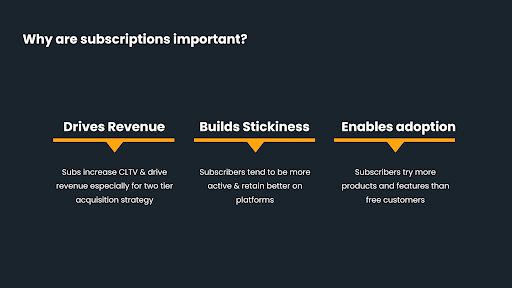Before we dive in, I want to ask a potentially controversial question: Do you use Bumble?
In case you’re not familiar with it, Bumble is a dating app. However, we’re not going to be talking too much about dating today. Instead, we’ll be focusing on subscription models, which I work on as the Associate Director of Growth Product Marketing at Bumble. More specifically, we’ll be talking about growing revenue through subscriptions.
Product marketing in the B2C space is still relatively new, so I’m excited to share some insights from the frontlines. Let’s jump in!
What are subscriptions and why are they important?
Subscriptions are a super-effective way for consumer companies to secure recurring revenue. Services like Amazon Prime and Spotify have made subscriptions a household concept. For consumer tech companies, subscriptions can help lock in customers and revenue while encouraging ongoing engagement.
One of the common types of subscription in the B2C space is the freemium model in which the core product is free and the premium version is paid. The premium version might offer you more features or, as in the case of Spotify, a more enjoyable experience by removing ads.
Subscriptions are critical for a few key reasons:
- They drive revenue and increase customer lifetime value (CLTV)
- They build stickiness as subscribers tend to remain engaged for longer
- They enable adoption by encouraging users to try more features

In short, subscriptions help consumer tech companies focus on creating long-term value vs. short-term user growth, providing stability and sustainability in the volatile world of consumer tech.
Product marketing’s role in driving subscription growth
So where does product marketing come into all of this? Well, at its core, product marketing is all about understanding users' needs, mapping journeys, and communicating value. These skills translate directly into crafting compelling subscription strategies.
When it comes to subscriptions, product marketers start by identifying what motivates users and their willingness to pay. What specific features or benefits are users willing to subscribe for? Building this understanding allows us to highlight the most appealing elements of a paid subscription in our messaging and value prop.
Beyond research, product marketers create hypotheses and run experiments to optimize the path to conversion. We leverage automation and CRM tools to scale learnings across campaigns. The goal is to continually refine targeting and messaging to boost opt-ins.
How to build a solid subscription strategy
An effective subscription strategy can be boiled down to three key phases: Educate, target, and convert. Let’s take a closer look.
Phase one: Educate
In the education phase, product marketers articulate a clear, consistent value proposition. We craft messaging that speaks to the functional and emotional benefits of subscribing. For new users, this means thoughtful onboarding to demonstrate the value. For existing subscribers, it's about reiterating the ongoing benefits to retain them.
Phase two: Target
The targeting phase is all about employing hyper-targeted, data-driven campaigns. On the B2C side with millions of users, a one-size-fits-all approach won't cut it. We optimize journeys for key user segments, tailoring the messaging and entry points to each audience. The goal is to reach users with the right message at those high-propensity moments when they're most likely to convert.
Phase three: Convert
Lastly, the conversion phase focuses on closing the deal. This is where tactics like limited-time offers, pricing incentives, and subscription plan recommendations come into play. The aim is to reduce the cognitive load on users as you nudge them over the finish line.
Crafting compelling value propositions
How many times has a product manager come to you, asking, "Our subscription offers X, Y, Z, and a thousand other things – why don't we tell customers about all of it?" It’s all too easy to cave in, but the reality is that leading with a laundry list of features overwhelms customers rather than compelling them.
As a product marketer, it’s your job to push teams to identify the single most important value proposition at any given moment. What’s the primary reason a user should upgrade or convert right now?
Here are some strategies to help you hone in on those key value props:
- Analyze usage patterns and conversion entry points: Where are people commonly upgrading from? At Bumble, our top entry points are around premium features like Beeline.
- Create hypotheses based on behavioral data: What goals are users trying to achieve? Getting matches? Starting conversations? Understanding user jobs to be done helps identify motivations.
- Validate with surveys and qualitative research: Speaking directly to customers provides clarity on why they upgraded. If you can, set up weekly customer calls.
- Test messaging with target audiences: Where possible, test how value prop variations perform to optimize.
The process is iterative, but focusing on users’ primary motivations for upgrading helps cut through the noise. Value props should speak to what the user cares about most in that moment versus every possible feature.
Leveraging contextual and cultural moments in messaging
Now let’s dive into some fun examples of how you can create timely messaging to grab users’ attention.
One effective messaging strategy is tapping into cultural or contextual moments to highlight a specific subscription feature.
For example, during the World Cup, we created messaging around soccer fans finding matches who shared their interest. The key promotion was around “advanced filters” which are part of our premium subscription. Rather than listing all premium features, we focused on how that one feature could help users connect with someone who shared their interest in soccer.

Similarly for Thanksgiving in the US, we highlighted travel mode, a feature that allows users to view profiles in their destinations before arriving there. The messaging focused on using travel mode to line up dates before leaving town for the holiday.
In both cases, we identified a cultural moment, connected it to a specific subscription feature, and crafted messaging around how that single feature could provide value in that context.
Tapping into pop culture, current events, or seasonal moments allows you to catch attention and tell a compelling, relevant story. And by focusing on one key feature, you cut through the noise rather than overwhelming users with everything your premium subscription offers.
Al Bumble, we continually experiment with these types of contextual campaigns to see what best resonates with our audiences. When done right, it’s a highly effective way to boost premium conversions by meeting users where they are.
How to leverage data for targeted messaging
While everyone talks about using data in product marketing, it’s easier said than done. With mountains of data at our fingertips, it’s critical to focus on clear goals and contexts. In subscription models, data offers major opportunities to target specific audiences.
Here are some great ways to do this:
- Identify quick wins based on behavior signals: If someone hits a usage limit, target them with messaging about the increased usage they’ll get if they upgrade. Solve their pain point.
- Optimize early user journeys: New users are most likely to upgrade out of curiosity to experience premium features. Getting them to convert early increases the likelihood of retention.
- Model your best customers: Analyze the behaviors of current premium subscribers to understand signals correlated with the likelihood of conversion. From there, you can target similar users.
- Test different user segments: Not all users respond equally to messaging. Build user clusters to identify which segments have the highest conversion potential when targeted.
- Personalize based on individual usage: Tailor messaging around the specific features a user engages with rather than generic premium pitches.
- Identify entry points and slice value props by audience: For example, at Bumble, we targeted older millennial women with messaging about our incognito mode feature. We made the decision to do so based on data showing that this user group was particularly concerned about privacy. As a result, we saw a huge uptick in upgrades among this demographic.
The key is using data tactically to serve the right message at the right time to the right customer. With the right framework, data takes the guesswork out of targeting.
Driving conversion with targeted incentives
For users who have a lower willingness to pay, incentives can provide that extra nudge needed to finally convert. Why not strategically use special offers and limited-time discounts to incentivize users who haven't responded to your core messaging?
Incentives are particularly helpful for bringing on new demographics where pricing may be a barrier, like college students. A well-timed promotion with discounted pricing can unlock this audience.
Of course, it’s vital to ensure the incentive messaging reinforces why the offer matters. Remind users of the core benefits and tie the discount or deal back to the value proposition.
While overusing incentives can devalue subscriptions, timed promotions are an invaluable tool for hitting growth goals and nudging fence-sitters over the line. With strategic messaging and tight targeting, incentives provide that final boost to scale up subscribers.
Let's recap
In many ways, the core principles of product marketing remain the same whether B2B or B2C. Crafting compelling value propositions, targeted messaging, and strategic experiments are all critical.
However, applying these fundamentals at the consumer scale brings unique challenges. Happily, by focusing on core product marketing fundamentals, you can overcome them.
First, nail your value prop and messaging. Use testing and experimentation to identify which features compel specific user segments. Adapt your messaging framework to resonate in the moment.
Second, optimize your targeting with precision. With millions of potential subscribers, hyper-targeted campaigns are essential for rising above the noise.
Finally, double down on what works. Leverage automation and CRM to scale your successful campaigns across channels.
The world of consumer subscriptions moves fast. But with the right approach to experimentation, optimization, and automation, product marketers have an invaluable opportunity to drive recurring revenue. By putting the user first, you can craft subscription programs that deliver real value amidst the chaos.


 Follow us on LinkedIn
Follow us on LinkedIn

